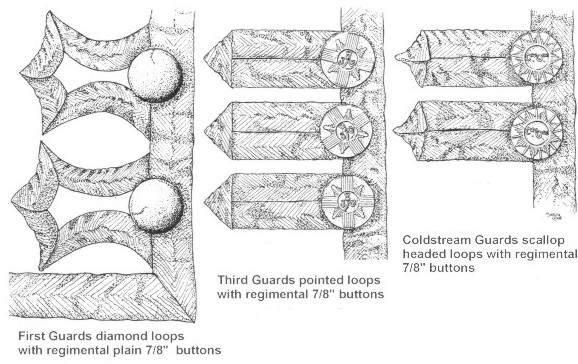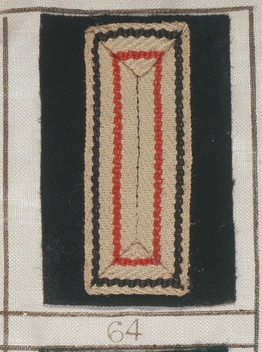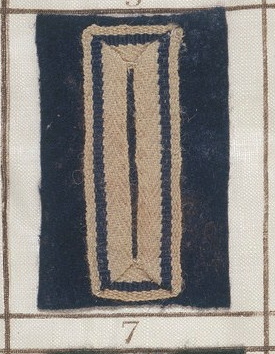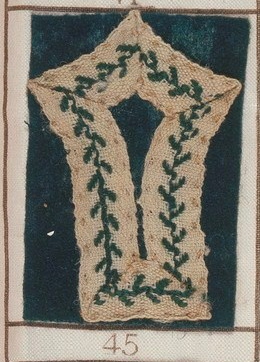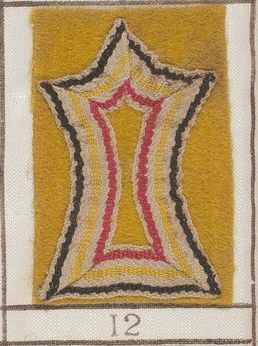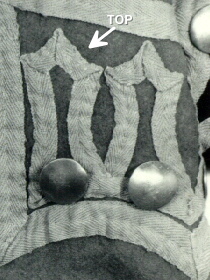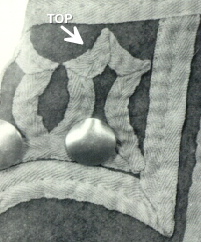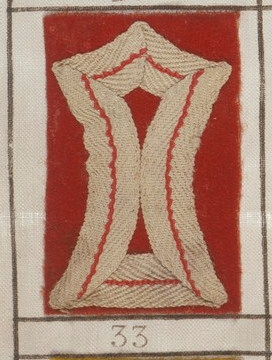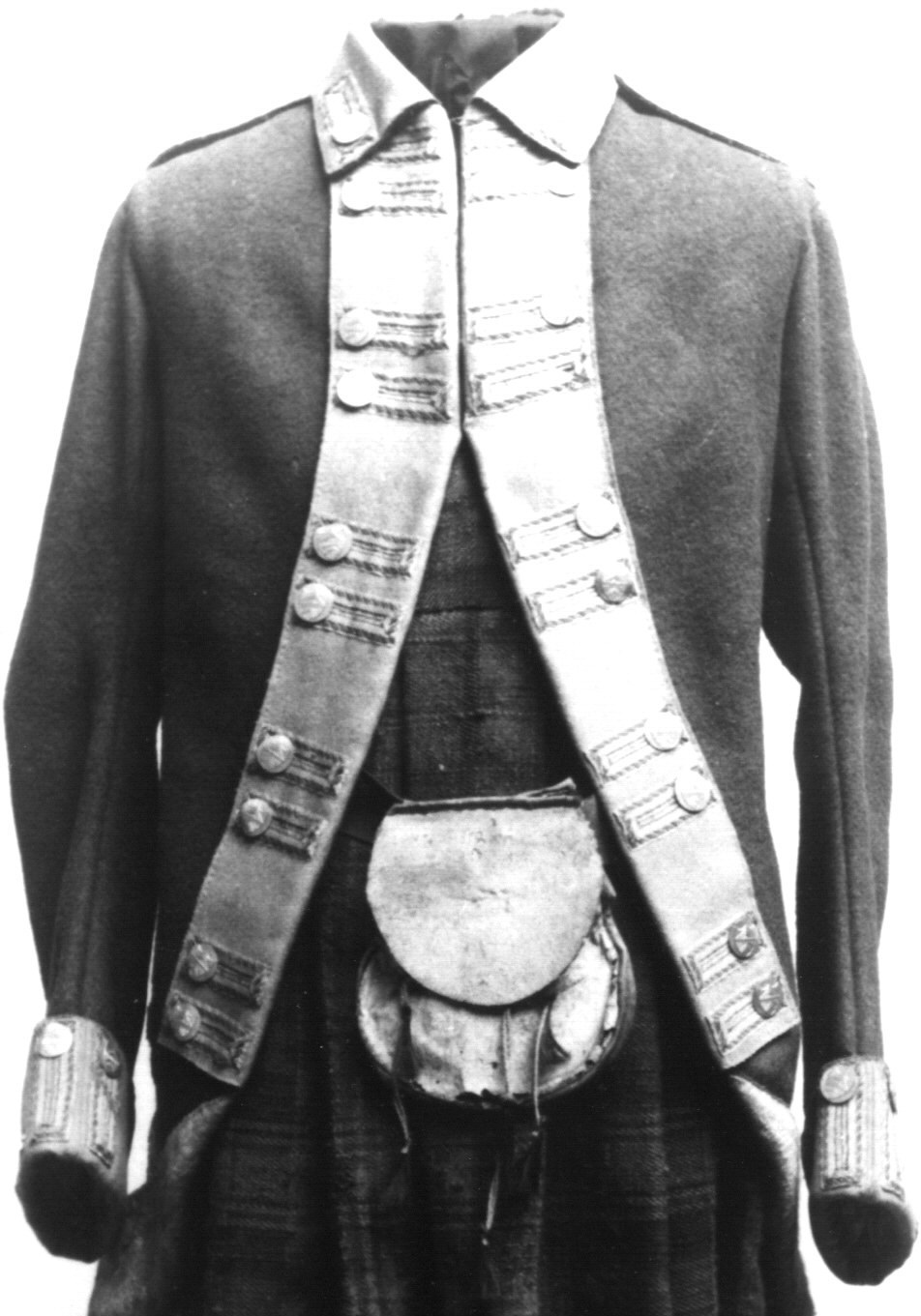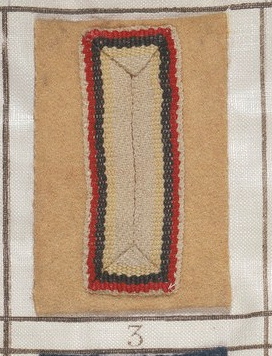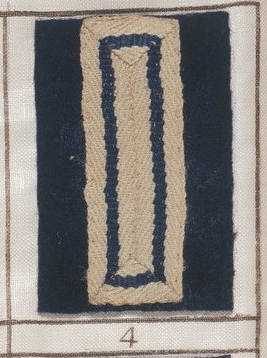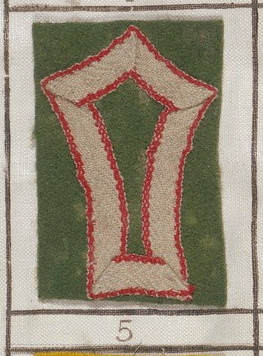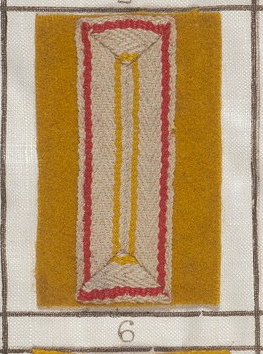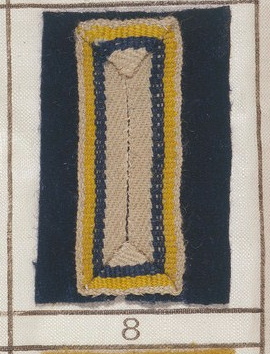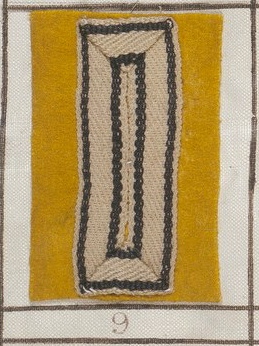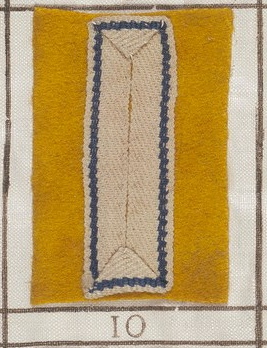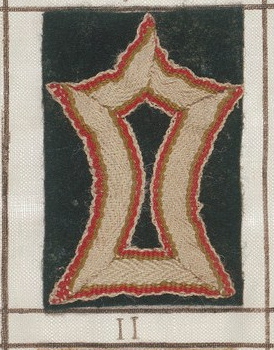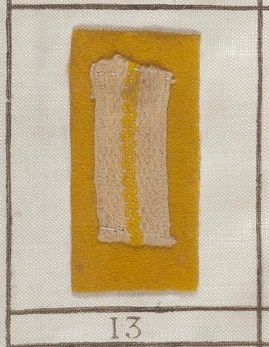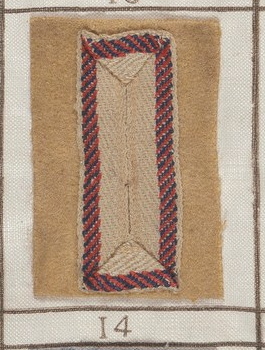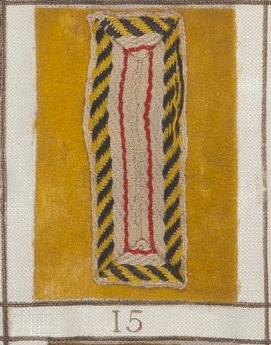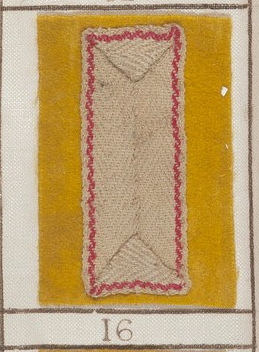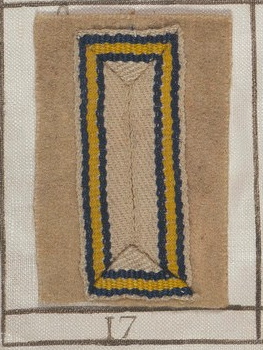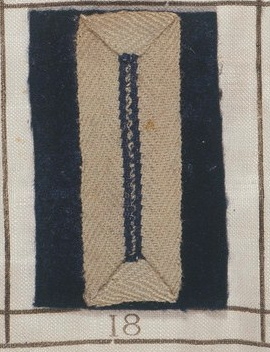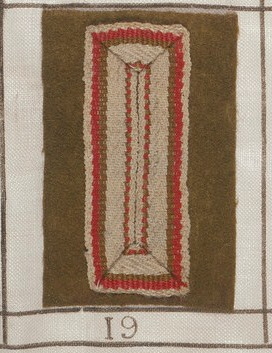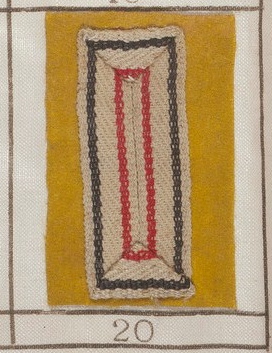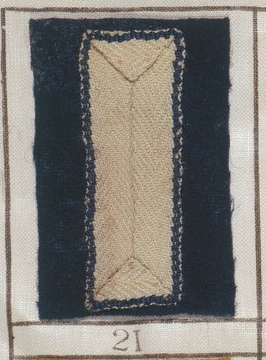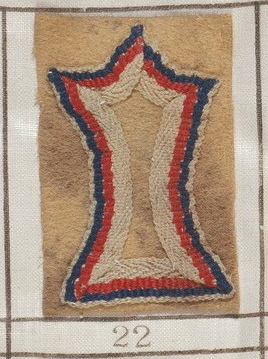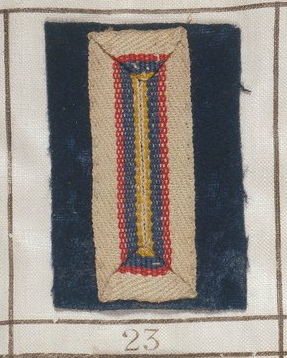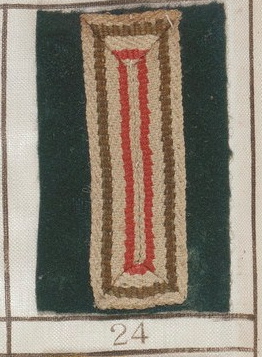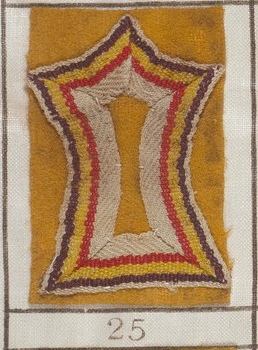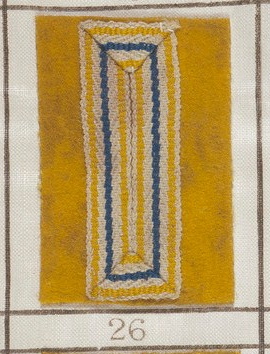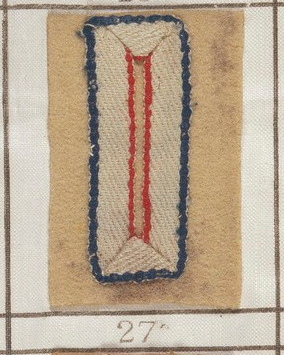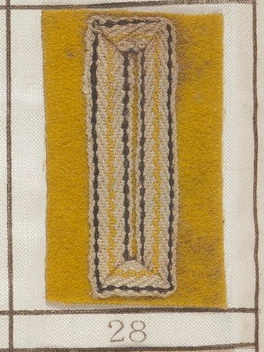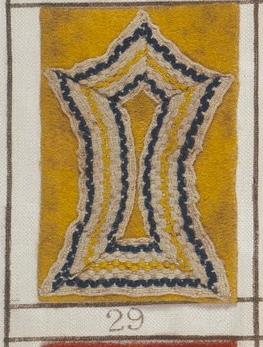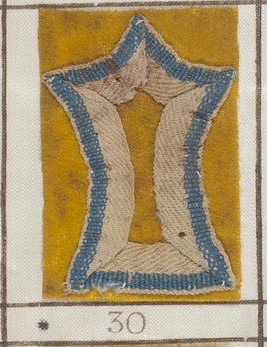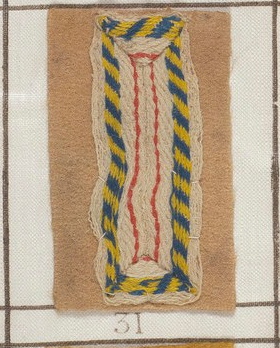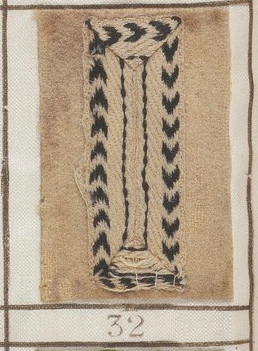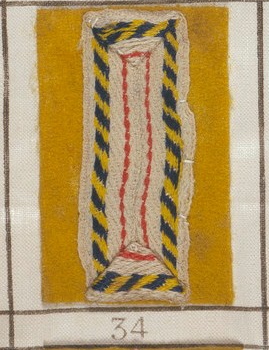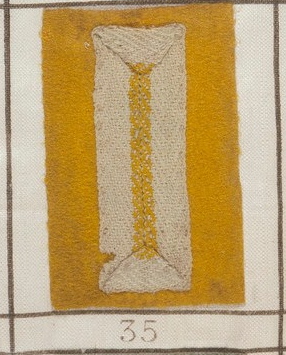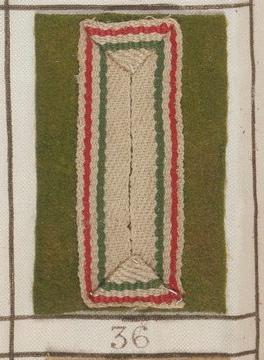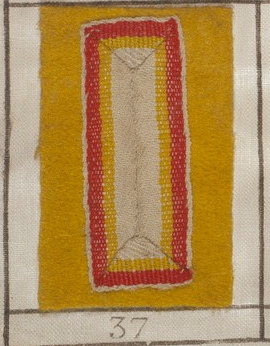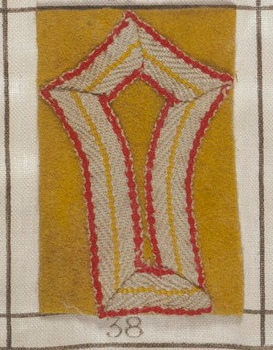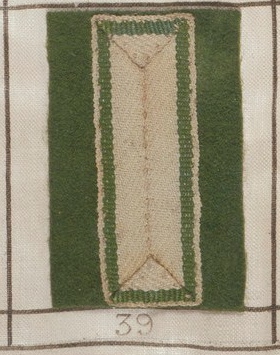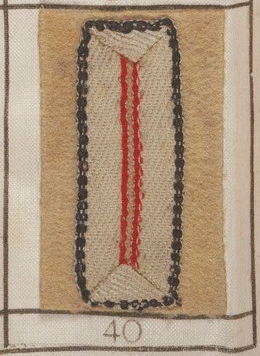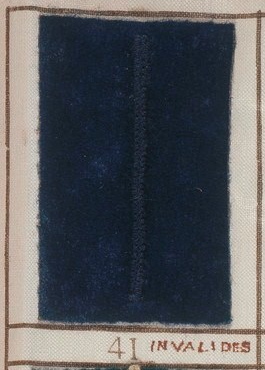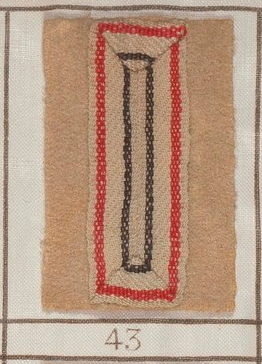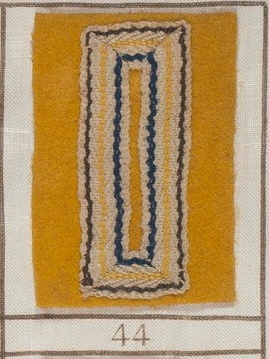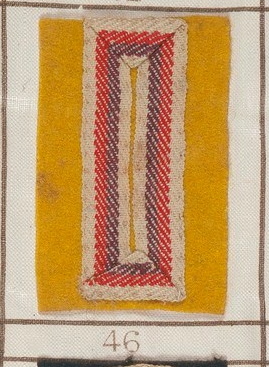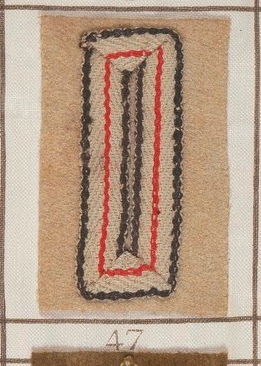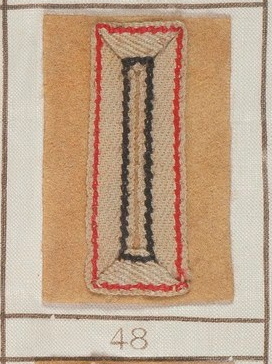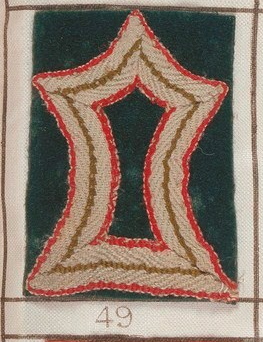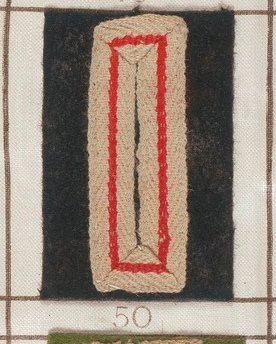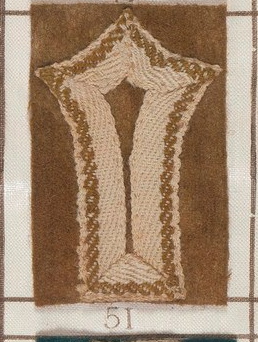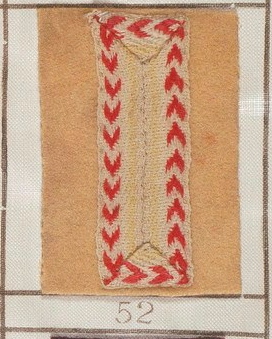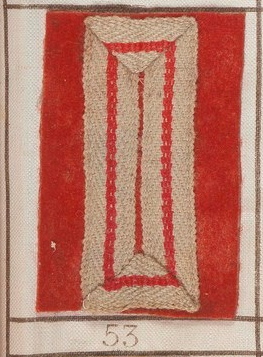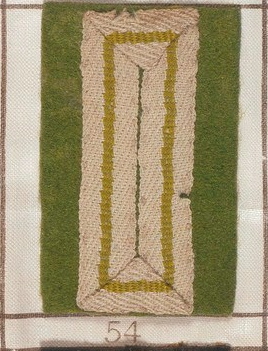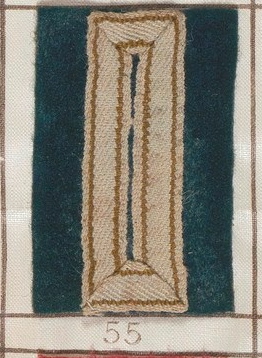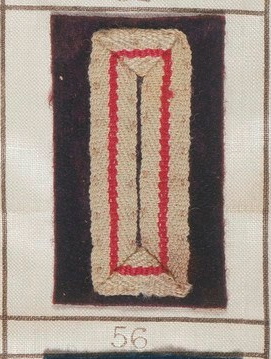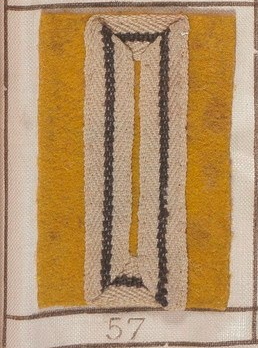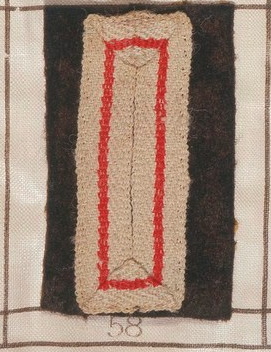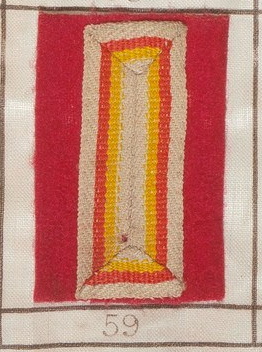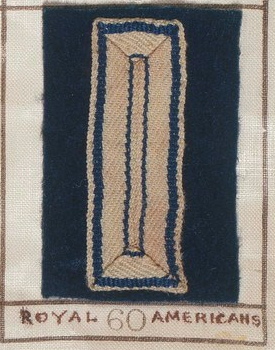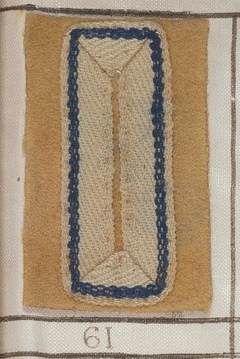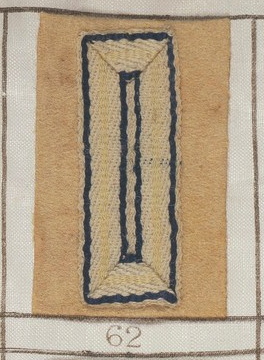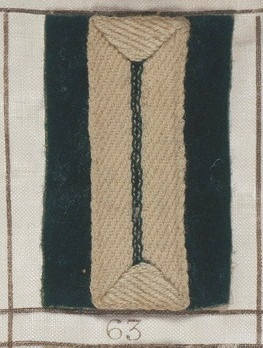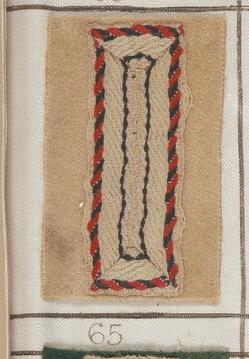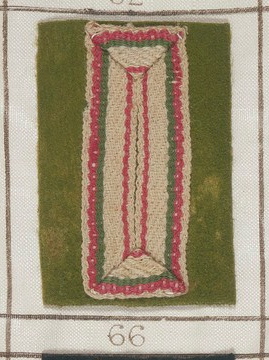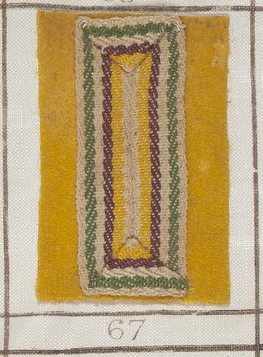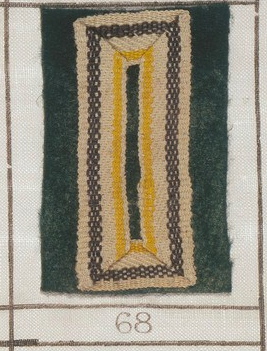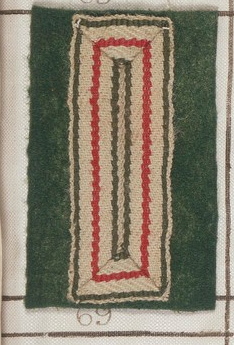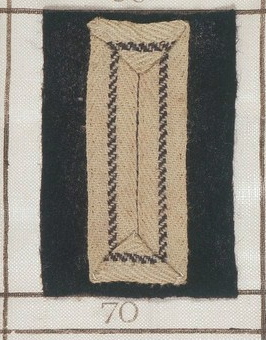Of the Lacing of British Enlisted Regimental Coats during the American War for Independence.
Part 1 - The Lace
On 19th December 1768 a new Clothing Warrant was issued for the Marching Regiments of Foot. To support this, a small volume was assembled containing sample lace loops from each of the first seventy Regiments of Foot. Commonly called “The Lace Book”, this book has been an invaluable resource to those who study and re-create the clothing of the British Army during the American War for Independence.
Thanks to the gracious permission of Emma Stuart, Senior Curator of Books and Manuscripts, high resolution scans of The Lace Book provide a fresh opportunity to study regimental looping in detail.
The Lace Book: inventory number RCIN 1085813.
Royal Collection Trust © Her Majesty Queen Elizabeth II 2015
Windsor Castle, Berkshire SL4 1NJ
Looping for the marching regiments comes in two broad categories; “rectangular” loops and “bastion” loops - so called because of the resemblance of the loop to the bastion of a fortification. Looping for the Guards can include “diamond”, “scallop headed”, and “pointed”, but that is outside the scope of this discussion.
Illustration from:
Preparing a British Unit for Service in America
The Brigade of Foot Guards, 1776
William W. Burke and Linnea M. Bass
Illustrations by Jeffrey A. Saeger
http://www.military-historians.org/company/journal/guards/guards.htm
As I discuss loops and looping, I am going to use some other terms that I created for my own convenience to describe variations in the way looping is folded. Rectangular loops can be folded in either “standard” or “inverted” fashion. Standard fashion means that the short ends of the loop are folded over to a point and rest on top of the long sides of the loop. Inverted fashion means that the short ends of the loop are folded under the long sides.
The images show a standard fashion loop of the 64th Regiment of Foot, next to an inverted fashion loop of the 7th Royal Fuziliers.
Bastion loops fall into two sub-categories. Square Ended Bastion Loops (SEBL), are squared off on the end opposite the bastion, and Flare Ended Bastion Loops (FEBL), are flared out to either side on the end opposite the bastion. I do not use the period terms “jew’s harp” and “flowerpot”, because debate still rages exactly which term refers to what shape.
These images show a SEBL of the 45th Regiment of Foot, next to a FEBL of the 12th Regiment of Foot.
All SEBL have standard fashion square ends, and all FEBL have inverted fashion flared ends. Things get interesting when we study the fold styles of the bastion end of a bastion loop. The bastion ends come in “left-handed”, “right-handed”, “upward fold”, and “clockwise” folding.
These greyscale images of a Foot Guards coat illustrate what a right-handed and left-handed bastion loops look like. On the left hand image, the bastion end of the loop has been folded in such a manner that the center fold and the right hand fold of the bastion end lay over the top of the adjacent lace, forming a right-handed “top” end on the right hand side of the loop. On a left-handed loop, the center fold and the left hand fold lay over the top of the adjacent lace, forming a “top” on the left hand side of the bastion.
On “upward fold” bastions, the lace on the long side of the loop is folded up in such a fashion that the folds lay on top of the bastion end of the loop. This FEBL of the 33rd Regiment of Foot shows how the long sides fold up over the bastion end of the loops.
For a “clockwise” bastion loop, the folds of the bastion end all lay over the adjacent lace, running in a clockwise fashion. This SEBL of the 42nd Royal Highland Regiment demonstrates “clockwise” folding.
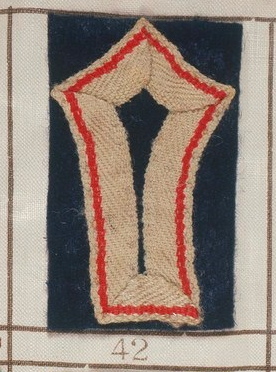
As I discuss each loop, I will give measurements estimated from the size of the on-screen image. The Royal Warrant gives us this scant information: “The breadth of the lace which is to make the loop round the buttonhole, is to be about half an inch”. With these high resolution scans, it is plain to see that there is quite a bit of variation in the width of the lace of the original lace samples. It is also possible to note variations in the weave. When I was studying the scans of the loops, I adjusted my monitor so that for the majority of the loops the lace comes out to one-half inch wide. Establishing this as 100% scale also allows me to measure the finished dimensions of a loop. There is much variation on this as well, which shows that some loops can span the entire width of the lappel, while others do not.
This handsomely looped coat shows a splendid example of looping that spans the entire with of the lappels. Also note that the looping spans nearly the entire width of the cuffs, which are a half inch wider than the lappels.
Regimental lace is applied with a stitch around the outer and inner edge of the loop, with the occasional whip stitch for reinforcement. Sometimes, there is a stitch down the center of the loop. Where I can, I will provide a stitch-per-inch count.
Were the loops pre-formed then sewn to the coat, or was the loop formed “off-the-roll”, by following a chalked outline, or perhaps even simply the tailor’s experience? It wouldn’t be that much of a challenge to create a rectangular loop off-the-roll, but bastion loops might be harder to do by eye. As I examined the loops, I looked for clues to point to either choice.
2nd, or Queen’s Royal Regiment.
Facings, blue. Lace, “white with blue stripe”. This is a rectangular loop, folded standard fashion. The lace is 9/16 inch wide, with a herringbone weave. The formed loop is 1 1/8 inches wide, and 2 1/2 inches long. There are a few whip stitches on the bottom edge of the loop. There are also single whip stitches visible inside the blue stripe at the remaining three corners. The lace is pulling loose on the bottom right corner, which demonstrates this is the corner where the lace ends meet.
3rd Regiment, or the Buffs.
Facings, buff. Lace, “white with yellow, black, and red stripe”. This is a rectangular loop, folded standard fashion. The lace is 15/32 inch wide, in a twill weave. The formed loop is 15/16 inch wide and 2 1/2 inches long. There are a couple of whip stitches tacking down the bottom right corner.
4th, or the King’s Own Regiment.
Facings, blue. Lace, “white with blue stripe”. This is a rectangular loop, folded standard fashion. The lace is 15/32 inch wide, in a herringbone weave. The formed loop is 31/32inch wide and 2 3/4 inches long. It is sewn at 7 SPI.
Please note that although the lace description is identical to that of the 2nd. or Queen’s Royal Regiment, the lace itself is dramatically different! This shows why The Lace Book can be such a valuable reference.
7th Regiment, or Royal Fuziliers.
Facings, blue. Lace, “white with blue stripe”. This is a rectangular loop, folded inverted fashion. The lace is 7/16 inch wide, in a herringbone weave. The formed loop is 15/16 inch wide with a 1/16 inch gap, and 2 3/8 inches long. It is sewn at 7 SPI. There is a tack stitch at the top right corner that suggests this is where the lace ends meet.
8th, or the King’s Regiment.
Facings, blue. Lace, “white with blue and yellow stripe”. The lace is 1/2 inch wide, in a twill weave. This is a rectangular loop, folded standard fashion. The formed loop is 1 inch wide and 2 3/8 inches long. A tack stitch is visible on the top right and bottom left corners, and there are some whip stitches holding the center closed.
18th, or Royal Irish Regiment.
Facings, blue. Lace, “white with a blue stripe”. This is a rectangular loop, folded standard fashion. The lace is 1/2 inch wide, in a herringbone weave. The formed loop is 1 inch wide and 2 3/4 inches long. It is stitched at 6 SPI.
21st Regiment or Royal North British Fusiliers.
Facings, blue. Lace, “white with a blue stripe”. This is a rectangular loop, folded standard fashion. The lace is 7/16 inch wide, in a herringbone weave. The formed loop varies from 1 inch wide at the top, to 29/32 inch wide at the bottom and is 2 5/8 inches long.
23rd Regiment or Royal Welch Fuzileers.
Facings, blue. Lace, “white with red, blue and yellow stripes”. This is a rectangular loop, folded standard fashion. The lace is 15/32 inch wide, in a twill weave. The formed loop is 31/32 wide and 2 9/16 inches long. It is sewn at 7 SPI.
27th, or Inniskilling Regiment.
Facings, buff. Lace, “white with one blue, and one red stripe”. This is a rectangular loop, folded standard fashion. The lace is 7/16 inch wide, in a twill weave. The formed loop is 1 inch wide, with a 3/32 inch gap in the center, and 2 1/2 inches long. A discontinuity at the top right corner suggests this is where the lace ends meet.
41st Regiment, or Invalids.
Facings, blue, with a “plain button-hole”. The buttonhole is bar tacked at the bottom end only, and is 2 1/2 inches long.
42nd Regiment, or Royal Highlanders.
Facings, blue. Lace, “white with a red stripe”. This is a SEBL, with a clockwise fold on the bastion end. The lace is 7/16 inch wide, in twill weave. The square end is 1 inch wide, The bastion end is 1 3/4 inches wide, and the loop 2 7/8 inches long. It is sewn at 5 SPI. There is un-evenness at the bottom right corner that suggests this is where the lace ends meet.
60th Regiment, or Royal Americans.
Facings, blue. Lace “white with two blue stripes”. This is a rectangular loop, folded standard fashion. The lace is 15/32 inch wide, in a twill weave. The formed loop is 7/8 inch wide and 2 9/16 inches long. Un-evenness at the bottom right corner suggests this is where the lace ends meet.
Of the 70 Regiments represented in The Lace Book, there are 68 looping samples to examine. The 41st Regiment (or Invalids) does not use looping, but has only a worked buttonhole, and the 13th Foot sent only a sample strip of lace. Granted, at 11/16 inch wide, it is the widest sample of lace in the lace book, and would have yielded a loop 1 3/8 inches wide! Lace in a twill weave was the most popular, followed by herringbone, with flat or braid weave a distant third.
Lace weave.
Twill.
■■■■■■■■■■■■■■■■■■■■■■■■■■■■■■■■■■■■■■ 38
Herringbone.
■■■■■■■■■■■■■■■■■■■■■■■■■■ 27
Flat or braid.
■■■ 3
Lace width.
The lace itself varied in width from 3/8 inch to 11/16th inch, with 1/2 inch being the most popular.
3/8 inch
■ 1
13/32 inch
■ 1
7/16 inch
■■■■■■■■■■■■■■■■■■■■■■■ 23
15/32 inch
■■■■■■■■■■■■■ 13
1/2 inch
■■■■■■■■■■■■■■■■■■■■■■■■■■■■ 28
9/16 inch
■■ 2
11/16 inch
■ 1
Of the looping styles, rectangular loops folded standard fashion were by far the most common, followed by Flare Ended Bastion Loops, Square Ended Bastion Loops, and rectangular loops folded inverted fashion.
Fold styles.
Rectangular loops, folded standard fashion
■■■■■■■■■■■■■■■■■■■■■■■■■■■■■■■■■■■■■■■■■■■■■■■■■■■ 51
FEBL
■■■■■■■■ 8
SEBL
■■■■■ 5
Rectangular Loops, folded inverted fashion.
■■■■ 4
Finished rectangular loops showed a variety of widths, from 13/16 inch up to 1 1/16 inch. Some of this was due to the width of the lace itself, and in some cases the width incorporated a gap in the center of the loop.
Formed width.
13/16 inch
■ 1
7/8 inch
■■■■■■ 6
15/16 inch
■■■■■■■■■■■■■■■■■■■ 19
31/32 inch
■■ 2
1 inch
■■■■■■■■■■■■■■■■■■■■■■■■■■■ 22
1 1/8 inch
■■ 2
1 1/16 inch
■■■ 3
Not every rectangular loop had a gap - in fact, most didn’t. Of those few with a gap, a narrow 1/16 inch was the most popular.
Gap.
1/16 inch
■■■■■■■■■■■ 11
3/32 inch
■■ 2
1/8 inch
■ 1
The most visible variation in rectangular loops is the length. The shortest were 2 3/8 inches, while the longest were a full 2 7/8 inches, which would span nearly the entire width of a lappel.
Formed length.
2 3/8 inches
■■■ 3
2 7/16 inches
■■ 2
2 1/2 inches
■■■■■■ 6
2 9/16 inches
■■■■■■■■■■■■■■■ 15
2 5/8 inches
■■■■■■■■■■■ 11
2 11/16 inches
■■■■■ 5
2 3/4 inches
■■■■■■■■■■■ 11
2 7/8 inches
■■
Square Ended Bastion Loops.
Of the five SEBL, none of them had an upward fold, four had a clockwise fold, and only one of them had a left hand fold.
Loop length.
2 9/16 inch
■
2 3/4 inch
■ 1
2 7/8 inch
■■ 2
2 15/16
■ 1
Loop width - bastion end.
1 5/8 inch
■ 1
1 11/16 inch
■
1 3/4 inch
■■ 2
2 inch
■
Loop width - square end.
15/16 inch
■ 1
1 inch
■■■ 3
1 3/16 inch
■ 1
Flared End Bastion Loops.
Of the eight FEBL, seven had upward folds on the bastion end, and one had a left hand fold.
Loop length.
2 5/8 inch
■■■■ 4
2 11/16 inch
■
2 3/4 inch
■■■ 3
Loop width - bastion end.
1 5/8 inch
■ 1
1 11/16 inch
■ 1
1 3/4 inch
■■ 2
1 13/16 inch
■ 1
1 7/8 inch
■■■ 3
Loop width - flared end.
1 11/16 inch
■ 1
1 5/8 inch
■■ 2
1 13/16 inch
■■ 2
1 3/4 inch
■■ 2
2 inch
■ 1
On many of the loops, the stitching was not visible. None of the loops appear to have been whip stitched around the entire outer edge. Whatever whip stitiching can be seen is on the corners and sometimes the points. On the loops where a stitch was visible it was possible to determine the stitches per inch.
4 SPI
■ 1
5 SPI
■ 1
6 SPI
■■■■■■■■■■■■ 12
7 SPI
■■■■■■■ 7
8 SPI
■■■■■■■■ 8
Only three loops showed evidence of an additional stitch down the center of the loop; the 12th, 30th, and 55th Foot.
It was sometimes possible to determine where the lace ends meet. This can aid in figuring out how the lace was formed and laid down on the fabric.
Corner where lace ends join.
Top Left
■■■■■■ 6
Top Right
■■■■ 4
Bottom Left.
■■■■■■■■■■■ 11
Bottom Right.
■■■■■■■■■■■■■■■■■■■■■■■■■■ 26
Part 2 of this article will present and discuss various styles of looping as shown on extant imagery and existing coats, along with practical tips on looping coats.

